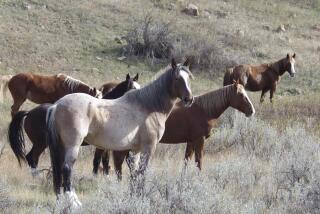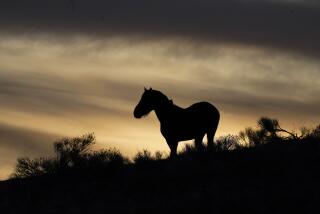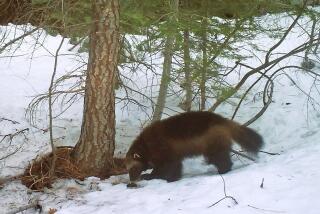Drought, Wildfires Add Urgent Note to BLM Wild Horse Adoption Program
- Share via
LARAMIE, Wyo. — When it comes to getting people to adopt wild horses, Bruce “Smoky” Stevens is not above begging on his knees, pulling cash out of his jeans and waving it around, and accusing the audience of falling asleep on the bleachers.
On a small scale, Stevens is doing what the U.S. Bureau of Land Management has started to do as drought and wildfire threaten wild horses in six Western states. The agency is pushing to get more people to adopt wild horses as pets and pack animals.
But although Stevens, a wild horse specialist for the bureau, may go to extremes to attract adopters, he said it remains a mystery to him what gets people to buy a wild horse. Lack of interest has been blamed on the price of hay, rural economic downturns and the perception that wild horses are stubborn and dangerous.
On a recent weekend, Stevens pulled out all of his tricks to cajole the crowd at Albany County fairgrounds. In the wind and dust, roughly half the wild horses went to homes.
“I can’t put my finger on it,” he said.
The bureau, which manages wild horses in 10 Western states, has spent about $100,000 since August on advertising across the country, including wild horse billboards and television commercials.
“We know that there are people out there that are interested,” said Janet Nordin, the bureau’s national public outreach coordinator in Reno. “We also know there is a tremendous number of people who do not know that there are wild horses, let alone a Bureau of Land Management.”
So far this year, the bureau has rounded up 2,863 wild horses in Nevada, Utah and California. Additional gathers of 749 horses are pending in Nevada and Oregon. Roundups of 3,590 wild horses are possible in California, Nevada, Oregon, Utah, Wyoming and Colorado.
The 92 horses that were trucked to the Albany County fairgrounds ranged from majestic to jug-headed and scruffy. There were palominos, chestnuts, sorrels and grays. One had a single blue eye; another with a hernia was being offered for $25.
As the horses trotted around the corral before an audience of about 100, some were partly trained, and others appeared to live up to their wild mystique. A pair of sorrels were the first on the block. But no one in the crowd ventured a bid.
“You get your first pick right here in Wyoming, folks,” an auctioneer, Scott Fluer, said. “All right, no seller.”
Three more wild horses ran out. Then another three. A strong-looking gray horse was sold to a single bidder for the minimum of $125.
“I’m making loans over here at 200% a day,” Stevens said, waving a wad of dollars he fished out of his jeans pocket.
The bidding started to pick up as the younger horses were ushered into the corral. The younger ones are seen as more trainable than older horses that have endured a lifetime of snakebites and mountain lion attacks.
Elk Buchanan, 21, in a sweat-soaked cowboy hat and jeans tucked into boots, had no trouble outbidding his scant competitors. He bought a pair of wild horses for use on a ranch in Garrett, Wyo.
Buchanan has never trained a wild horse, but he knows history is on his side in human-horse relations. Wild horses and burros are descendants of animals released by or escaped from Spanish explorers, ranchers, miners, soldiers and American Indians.
“Show them a little TLC, take some time. Even if it takes a year, you can get them broke,” Buchanan said.
Wild horses and burros have proliferated on the range to about 48,000, an amount the bureau believes is unhealthy for the environment and for those who use it, such as ranchers.
The population is expected to reach 126,380 by decade’s end without additional efforts to keep the numbers down, the bureau says.
In some horse circles, the bureau has a way to go to promote the wild horse as a living symbol of the West.
“The poor little mustang, it’s a mutt horse,” said Brent Allen, president of the American Equestrian Alliance, an insurance company for horse owners in Phoenix. “For most people who know horses, that’s not their breed of choice.”
Allen said he worries the adoption program cannot ensure that wild horses will find good homes because they are being offered so cheaply.
The horses are sold for a minimum of $125, or as low as $25 if vet bills are anticipated.
“In the community of horsemen, the wild horse adoption program really churns up emotions,” Allen said. “A horseman would often rather see a horse destroyed than suffer. Some people probably think they’re buying their little girl a horse like they’re buying a bunny rabbit. But horses are really high maintenance.”
The wild horse fan club has grown to more than a dozen organizations. Some have traced the animals’ lineage back to Spanish explorers. Several registries allow people to claim wild horses as a breed.
Many wild horses have larger hooves, which allow them to roam the rough terrain with a steady gait. Often they have thickly boned, strong legs. They are protected by federal law.
Supporters are enthusiastic, saying wild horses make domesticated horses seem pampered and spoiled, with their supplemental vitamins, brushings, warm winter barns and blankets.
At the fairgrounds, some horses’ ribs were visible because of the drought, although they were nowhere near as emaciated as they were before they entered government-run facilities, Stevens said.
After two hours of the auction, the unsold horses were loaded into trucks and driven to holding facilities in Rock Springs and Elm Creek, Neb. They will eventually leave for other adoption events throughout the country.
More to Read
Sign up for Essential California
The most important California stories and recommendations in your inbox every morning.
You may occasionally receive promotional content from the Los Angeles Times.










